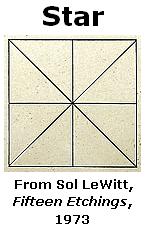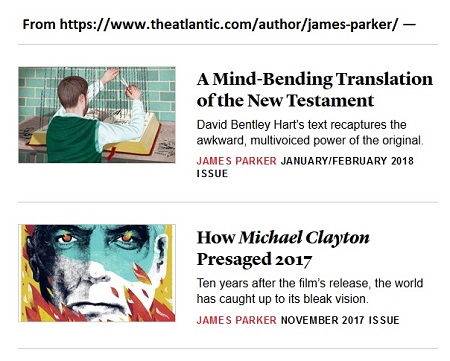Sunday, August 12, 2018
Preoccupied
Sunday, April 19, 2015
Preoccupied
"The Cardinal seemed a little preoccupied today."
See also a post found via a search in
this journal for "April 19 ".
Thursday, August 8, 2024
Annals of Accidental Branding
Columnist Rex Huppke in USA Today this morning —
". . . presidential nominee Donald Trump . . .
seems otherwise preoccupied with posting
unhinged rants on social media . . . ."
Huppke's self-description —

Wednesday, July 18, 2018
Doodle
From "The Educated Imagination: A Website Dedicated
to Northrop Frye" —
"In one of the notebooks for his first Bible book Frye writes,
'For at least 25 years I’ve been preoccupied by
the notion of a key to all mythologies.' . . . .
Frye made a valiant effort to provide a key to all mythology,
trying to fit everything into what he called the Great Doodle. . . ."
From a different page at the same website —

Here Frye provides a diagram of four sextets.
I prefer the Miracle Octad Generator of R. T. Curtis —
 .
.
Sunday, November 12, 2017
Devil’s Music
From the groom in the previous post — Swedenborg Chapel —
And from November 7 last year —
Monday, November 7, 2016
Subway Art for Times Square ChurchFiled under: Uncategorized — m759 @ 9:11 PM Click images for related material. |
Sunday, October 8, 2017
Sunday, June 5, 2016
The Shining of May 29…
A death on May 29, from The Fresno Bee —
See as well "La Diadema de la Muerte."
Friday, April 24, 2015
Harvard Class Day Speaker
This year's Class Day speaker at Harvard
will be Natalie Portman.
Related material:
See also the link to Preoccupied from Sunday—
"The Cardinal seemed a little preoccupied today."
Sunday, October 27, 2013
Days of Future Past
"The Cardinal seemed a little preoccupied today."
The New Yorker , May 13, 2002
See also Log24 , January 8, 2012.
" … Had they deceived us
Or deceived themselves, the quiet-voiced elders,
Bequeathing us merely a receipt for deceit?"
— Four Quartets
Wednesday, June 5, 2013
Rubric
From a mathematical review:
"The book ends with eye-opening explorations….
If pressed for an extra rubric, I would consider
a separate section on "Engaging Games," as
this is something that mathematicians are
preoccupied with— literally and metaphorically."
See in this journal Language Game, Nexus, and
posts of May 12, 2013.
Sunday, April 22, 2012
The Gospel According to Xbox
"Every multiplayer game, both free-for-all and team based,
will begin with a Mexican standoff." —Wikipedia
"The Cardinal seemed a little preoccupied today."
Sunday, January 22, 2012
Egress
Sunday, January 8, 2012
Big Apple

“…the nonlinear characterization of Billy Pilgrim
emphasizes that he is not simply an established
identity who undergoes a series of changes but
all the different things he is at different times.”

This suggests that the above structure
be viewed as illustrating not eight parts
but rather 8! = 40,320 parts.
"The Cardinal seemed a little preoccupied today."
The New Yorker , May 13, 2002
See also a note of May 14 , 2002.
Friday, December 9, 2011
Duality
Some background for last night's post on Diego Rivera—

See "Octavio Paz" + "Solar Country" in this journal.
"Mexico is a solar country— but it is also a black country, a dark country.
This duality of Mexico has preoccupied me since I was a child."
Tuesday, April 7, 2009
Tuesday April 7, 2009
|
Bright Star and Dark Lady “Mexico is a solar country — but it is also a black country, a dark country. This duality of Mexico has preoccupied me since I was a child.” — Octavio Paz, |
||
|
Bright Star
|
Amen.
|
Dark Lady
|
The same story on
May 11, 2005
with a different
dark lady:

Saturday, April 19, 2008
Saturday April 19, 2008
by the Associated Press–
April 19, 2008–
“On this date….
Ten years ago….
Mexican poet-philosopher
Octavio Paz died at age 84.”
“Mexico is a solar country–
but it is also a black country,
a dark country. This duality
of Mexico has preoccupied
me since I was a child.”
— Octavio Paz, as quoted
by Homero Aridjis
darkness; and the darkness
comprehended it not.”
— John 1:5
Saturday, June 25, 2005
Saturday June 25, 2005
Religious Symbolism
at Midnight:

Related material:
Star Wars 6/13/05,
Dark City 6/14/05,
and De Arco, as well
as the following from
July 26, 2003:
|
Bright Star and Dark Lady "Mexico is a solar country — but it is also a black country, a dark country. This duality of Mexico has preoccupied me since I was a child."
— Octavio Paz, |
||
|
Bright Star
|
Amen.
|
Dark Lady
|
Tuesday, May 24, 2005
Tuesday May 24, 2005
Two Poles
From today’s New York Times:

From erraticimpact.com on Paul Ricoeur:
the narratologist Algirdas-Julien Greimas.
between the philosophical and religious
domains, attempting to reconcile
the two poles in his thought.”
| From today’s NYT obituary of Sol Stetin:
“Mr. Stetin, who emigrated from Poland at the age of 10 and dropped out of high school in the ninth grade, was fond of saying he got his education in the labor movement.” |
 |
continued:
“… it is not in isolation that the rhetorical power of such oppositions resides, but in their articulation in relation to other oppositions. In Aristotle’s Physics the four elements of earth, air, fire and water were said to be opposed in pairs. For more than two thousand years oppositional patterns based on these four elements were widely accepted as the fundamental structure underlying surface reality….
 The structuralist semiotician Algirdas Greimas introduced the semiotic square (which he adapted from the ‘logical square’ of scholastic philosophy) as a means of analysing paired concepts more fully….”
The structuralist semiotician Algirdas Greimas introduced the semiotic square (which he adapted from the ‘logical square’ of scholastic philosophy) as a means of analysing paired concepts more fully….”
— Daniel Chandler, Semiotics for Beginners
Poetry’s Bones and
Theme and Variations.
Other readings on polarity:
Log24, May 24, 2003, and
from July 26, 2003:
|
Bright Star and Dark Lady “Mexico is a solar country — but it is also a black country, a dark country. This duality of Mexico has preoccupied me since I was a child.” — Octavio Paz, |
||
|
Bright Star
|
Amen. |
Dark Lady
|
Sunday, October 26, 2003
Sunday October 26, 2003
ART WARS for
Trotsky’s Birthday
Part I:
Symbols
From my entry of July 26, 2003, in memory
of Marathon Man director John Schlesinger:
|
Bright Star and Dark Lady “Mexico is a solar country — but it is also a black country, a dark country. This duality of Mexico has preoccupied me since I was a child.” — Octavio Paz, |
||
|
Bright Star
|
Amen. |
Dark Lady
|
For the meaning of the above symbols, see
Kubrick’s 1x4x9 monolith in 2001,
the Halmos tombstone in Measure Theory,
and the Fritz Leiber Changewar stories.
Part II:
Sunday in the Park with Death
To Leon from Diego —
Details of a mural,
A Dream of a Sunday Afternoon
in Alameda Park,
Fresco, 1947-48,
Alameda Hotel, Mexico City:
Three’s a Crowd:
Symbol:
Saturday, July 26, 2003
Saturday July 26, 2003
Funeral March
|
John Schlesinger dead at 77; LOS ANGELES – Oscar-winning director John Schlesinger, who daringly brought gay characters into mainstream cinema with Midnight Cowboy and tapped into nightmares with the teeth-drilling torture of Marathon Man, died Friday at 77. The British-born filmmaker…. died about 5:30 a.m…. |
Schlesinger also directed The Day of the Locust, based on a novel by Nathanael West.
See Heaven, Hell, and Hollywood and
From the latter:
“Then you know your body’s sent,
Don’t care if you don’t pay rent,
Sky is high and so am I,
If you’re a viper — a vi-paah.”
— The Day of the Locust,
by Nathanael West (1939),
New Directions paperback,
1969, page 162
This song may be downloaded at
That same site begins with a traditional Mexican song…
“La cucaracha, la cucaracha,
ya no puede caminar,
porque no quiere,
porque le falta
marihuana que fumar.”
(“The cockroach, the cockroach,
can’t walk anymore,
because he doesn’t want to,
because he has no
marihuana to smoke.”)
This suggests an appropriate funeral march for John Schlesinger:
“Ya murió la cucaracha, ya la llevan a enterrar…” – La Cucaracha
Those attending Schlesinger’s wake, as opposed to his funeral, may wish to perform other numbers from the Pot Culture page, which offers a variety of “viper” songs.
|
Bright Star and Dark Lady “Mexico is a solar country — but it is also a black country, a dark country. This duality of Mexico has preoccupied me since I was a child.” — Octavio Paz, |
||
|
Bright Star
|
Amen.
|
Dark Lady
|
For the meaning of the above symbols, see
Kubrick’s 1x4x9 monolith in 2001,
the Halmos tombstone in Measure Theory,
and the Fritz Leiber Changewar stories.
Concluding Unscientific Postscript:
Oh, yes… the question of
Heaven or Hell for John Schlesinger…
Recall that he also directed the delightful
Cold Comfort Farm and see
last year’s entry for this date.
Saturday, April 19, 2003
Saturday April 19, 2003
Harrowing
In memory of the many who have died on April 19, most notably Octavio Paz.
"There is a suggestion of Christ descending into the abyss for the harrowing of Hell. But it is the Consul whom we think of here, rather than of Christ."
— Introduction to Malcolm Lowry's classic novel Under the Volcano, by Stephen Spender
|
|
|
"Hey, big Spender, spend a little time
with me." — Song lyric
For a somewhat deeper meditation on time, see Architecture of Eternity.
See also Literature of the Descent into Hell.
"Mexico is a solar country — but it is also a black country, a dark country. This duality of Mexico has preoccupied me since I was a child."
— Octavio Paz, quoted by Homero Aridjis

Amen.
Concluding Unscientific Postscripts:
"Once upon a time…" — Anonymous
"It's quarter to three…" — Sinatra
Wednesday, November 27, 2002
Wednesday November 27, 2002
Waiting for Logos
Searching for background on the phrase "logos and logic" in yesterday's "Notes toward a Supreme Fact," I found this passage:
"…a theory of psychology based on the idea of the soul as the dialectical, self-contradictory syzygy of a) soul as anima and b) soul as animus. Jungian and archetypal psychology appear to have taken heed more or less of only one half of the whole syzygy, predominantly serving an anima cut loose from her own Other, the animus as logos and logic (whose first and most extreme phenomenological image is the killer of the anima, Bluebeard). Thus psychology tends to defend the virginal innocence of the anima and her imagination…"
— Wolfgang Giegerich, "Once More the Reality/Irreality Issue: A Reply to Hillman's Reply," website
The anima and other Jungian concepts are used to analyze Wallace Stevens in an excellent essay by Michael Bryson, "The Quest for the Fiction of an Absolute." Part of Bryson's motivation in this essay is the conflict between the trendy leftist nominalism of postmodern critics and the conservative realism of more traditional critics:
"David Jarraway, in his Stevens and the Question of Belief, writes about a Stevens figured as a proto-deconstructionist, insisting on 'Steven's insistence on dismantling the logocentric models of belief' (311) in 'An Ordinary Evening in New Haven.' In opposition to these readings comes a work like Janet McCann's Wallace Stevens Revisited: 'The Celestial Possible', in which the claim is made (speaking of the post-1940 period of Stevens' life) that 'God preoccupied him for the rest of his career.'"
Here "logocentric" is a buzz word for "Christian." Stevens, unlike the postmodernists, was not anti-Christian. He did, however, see that the old structures of belief could not be maintained indefinitely, and pondered what could be found to replace them. "Notes toward a Supreme Fiction" deals with this problem. In his essay on Stevens' "Notes," Bryson emphasizes the "negative capability" of Keats as a contemplative technique:
"The willingness to exist in a state of negative capability, to accept that sometimes what we are seeking is not that which reason can impose…."
For some related material, see Simone Weil's remarks on Electra waiting for her brother Orestes. Simone Weil's brother was one of the greatest mathematicians of the past century, André Weil.
"Electra did not seek Orestes, she waited for him…"
— Simone Weil
"…at the end, she pulls it all together brilliantly in the story of Electra and Orestes, where the importance of waiting on God rather than seeking is brought home forcefully."
— Tom Hinkle, review of Waiting for God
Compare her remarks on waiting for Orestes with the following passage from Waiting for God:
"We do not obtain the most precious gifts by going in search of them but by waiting for them. Man cannot discover them by his own powers, and if he sets out to seek for them he will find in their place counterfeits of which he will be unable to discern falsity.
The solution of a geometry problem does not in itself constitute a precious gift, but the same law applies to it because it is the image of something precious. Being a little fragment of particular truth, it is a pure image of the unique, eternal, and living Truth, the very Truth that once in a human voice declared: "I am the Truth."
Every school exercise, thought of in this way, is like a sacrament.
In every school exercise there is a special way of waiting upon truth, setting our hearts upon it, yet not allowing ourselves to go out in search of it. There is a way of giving our attention to the data of a problem in geometry without trying to find the solution…."
— Simone Weil, "Reflections on the Right Use of School Studies with a View to the Love of God"
Weil concludes the preceding essay with the following passage:
"Academic work is one of those fields containing a pearl so precious that it is worth while to sell all of our possessions, keeping nothing for ourselves, in order to be able to acquire it."
This biblical metaphor is also echoed in the work of Pascal, who combined in one person the theological talent of Simone Weil and the mathematical talent of her brother. After discussing how proofs should be written, Pascal says
"The method of not erring is sought by all the world. The logicians profess to guide to it, the geometricians alone attain it, and apart from their science, and the imitations of it, there are no true demonstrations. The whole art is included in the simple precepts that we have given; they alone are sufficient, they alone afford proofs; all other rules are useless or injurious. This I know by long experience of all kinds of books and persons.
And on this point I pass the same judgment as those who say that geometricians give them nothing new by these rules, because they possessed them in reality, but confounded with a multitude of others, either useless or false, from which they could not discriminate them, as those who, seeking a diamond of great price amidst a number of false ones, but from which they know not how to distinguish it, should boast, in holding them all together, of possessing the true one equally with him who without pausing at this mass of rubbish lays his hand upon the costly stone which they are seeking and for which they do not throw away the rest."
— Blaise Pascal, The Art of Persuasion




















